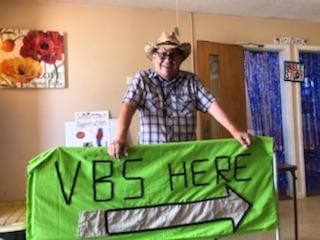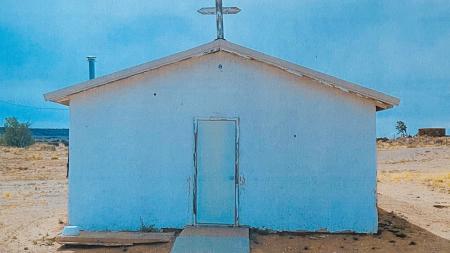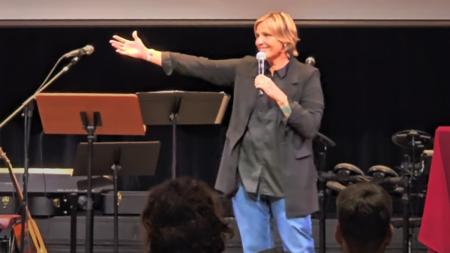Stanley Jim’s Vision for Leadership in Red Mesa

Moses Chung
Rev. Stanley Jim had an empty balloon in his hand as he spoke to the children attending vacation Bible school at Window Rock (Ariz.) Christian Reformed Church.
The VBS theme was “When you walk through the waters, remember God is with you,” based on Isaiah 43:2. On the sanctuary stage, behind Jim, was a “waterfall” made of silver streamers and a tent that welcomed the VBS campers. In another room, a Navajo teacher was using plastic fish to teach a lesson.
The balloon Jim held represented a life raft, he said.
“Sometimes in your lifetime you will feel like this — an empty balloon.” Then he blew into the balloon and showed how it took shape.
“But when you blow it up, this is when [your life] is full and you can float,” said Jim. “The Holy Spirit will fill you and your raft so you can float.”
Throughout the morning, Jim had been dashing between craft and teaching stations, blowing a whistle to let everyone know a new session had begun. For years this well-respected Navajo leader worked as an ethnic ministry leader for Christian Reformed Home Missions (now part of Resonate Global Mission), but now he is settling gratefully into parish ministry.
His presentation using the balloon was the last one of the morning. As the children left and teachers cleaned up, Jim took two visitors out to lunch at a restaurant near the church to talk about his ministry work and especially about training new leaders.
Taking a seat in the restaurant, Jim said that on Monday mornings tribal leaders of the Navajo Nation, based in Window Rock, usually meet here, and sometimes Jim is invited to pray for them and their work on the reservation.
After ordering lunch, Jim spoke of how the Holy Spirit who can fill our lives began especially to fill Classis Red Mesa after the formation of a new Leadership Development Network (LDN), a three-year program designed to train Indigenous leaders and pastors.
“The best thing that ever happened to us here is the leadership development,” said Jim. “It is helping people rely on themselves instead of someone else coming here to help us.”
Rev. Rob Byker, pastor of Rehoboth CRC, credits Jim with capturing the vision for Indigenous leadership development in Classis Red Mesa, which for years had assistance from Home Missions in funding ministry in churches.
But in the late 1990s, it was becoming clear that for various reasons Home Missions was developing other priorities for ministry, and that meant there would be changes in the ways Red Mesa churches were supported.
As this transition occurred, Stanley Jim saw an opportunity to develop a much-needed sense of ownership among the Indigenous peoples in the Red Mesa churches. And with "gracious" funding for several years from Home Missions, said Byker, Jim and others were able to move ahead to form LDN.
“In 2001, Stanley Jim urged Classis Red Mesa to move from ‘Missioned to Mission,’” said Byker, who has been involved in the LDN from the start. “He did not want the people of Red Mesa to view themselves as merely recipients of Anglo mission but as actual mission workers to lost neighbors. The LDN has been a key tool in developing mission-minded leaders in Red Mesa."
In September 2003, Classis Red Mesa approved a “Stanley-inspired” motion to adopt and approve the Red Mesa Indigenous Leadership Development Program. It was adopted, and then it took time to put together a program that met the needs of Indigenous peoples, said Byker.
In September of 2007, Pastor Susan LaClear of Maranatha Fellowship CRC in Farmington, N.Mex., and her mother, Ruth Bennally, began meeting with classis leaders, and they developed a workable LDN model. Jim’s wife, Sharon, was also instrumental in getting the program up and running.
“Of the nine students to enroll in the first year of the LDN program, several were people that Stanley identified as potential leaders,” said Byker. “I remember he made a significant
investment in some of those early leaders and was happy to shepherd them into the LDN program.”
The LDN meets twice a month, alternating between Rehoboth (N.Mex.) CRC and Maranatha Fellowship CRC in Farmington, N.Mex. About 30 people have graduated from the program over the past decade.
Jim said that the key to good leadership is working in partnership with others. “I’m not here to work for someone but to partner with you. That was my upbringing. Being a pastor means being a partner,” he said.
He often tells young leaders to keep their minds, hearts, and ears attuned to what is going on around them and to what others are saying, especially in a church setting. “We need to be open and shaped by the church so we can become messengers for Christ,” Jim said.
Serving with Home Missions was a challenging job, involving a great deal of travel, said Jim, and yet it also allowed him to work among the churches in Red Mesa as they developed the LDN program.
After experiencing the call to parish ministry, Jim left Home Missions in 2016 to become the pastor at Window Rock.
When he arrived, the church needed a new roof and other repairs. But he dove in, finding people and churches to help, and connected with a church willing to donate a sound system to Window Rock CRC.
Having been in ministry for many years, and having played a role in helping to build the ministry of others, Jim is a leader who turns to God regularly for guidance.
“God chooses different people for different jobs,” he said. “Whenever you want to say ‘yes,’ the Spirit will get hold of you. . . . Much of ministry is being willing to take a risk, and God will take us as far as we’re willing to go.”
The sermons he preaches on Sundays at Window Rock are based in Reformed theology that has close connections to Native American experience.
“We understand the covenant of grace. In our culture, the child is part of your family for the rest of your life,” said Jim.
In the past, Navajos were taught that there is a difference between the sacred and the secular. But elements of that are changing as Indigenous leaders take their place in the Red Mesa churches.
“Navajos used to believe everything is sacred,” said Jim. Then, referring to a quote by Reformed theologian Abraham Kuyper, he added, “If you start by going back to [recognizing that] ‘every square inch’ of the world is full of the activity of God, I embrace that as a Navajo person.”


